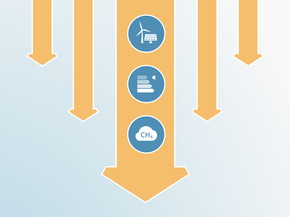Assumptions
Historical emissions
Historical emissions data for 1990–2021 were obtained from the UK Government (BEIS & DESNZ 2023a). Provisional emissions data for 2022 was also included to extend the time series to 2021 (BEIS & DESNZ 2023b). The UK provides inventory data to the UNFCCC that includes emissions from Overseas Territories and Crown Dependencies, which are not covered by UK climate policy and are not included in government emission projections. For this reason, we have chosen to use national emissions statistics rather than UNFCCC inventory emissions.
NDC and other targets
The UK’s 2030 NDC target of at least a 68% reduction below 1990 levels is expressed using 100 year global warming potentials (GWP100) from the IPCC’s Fifth Assessment Report (AR5) (UK Government 2022i). Consequently, we initially calculate the 2030 emissions implied by the UK’s NDC using AR5 GWPs. In addition, the UK Government has specified that the baseline will also use F-gas emissions from 1995. This alternative F-gas baseline is used when calculating the implied 2030 emissions level.
As the CAT presents all data across countries in GWP from the IPCC Fourth Assessment Report (AR4), the 2030 emissions implied by the NDC target in AR5 GWPs are then converted back into AR4 GWP. This is done by calculating a historical conversion factor from AR5 GWPs to AR4 GWPs, using historical data from 2021. This conversion factor can then be used to calculate the NDC in 2030 in AR4 GWPs.
The UK’s 2030 (NDC) and 2035 (Sixth Carbon Budget) emissions targets includes LULUCF emissions. This needs to be subtracted for comparability with other countries. We use projections from the CCC’s Sixth Carbon Budget to estimate LULUCF emissions in 2030 and 2035 (CCC 2020). While the government’s approach to achieving the NDC and Sixth Carbon Budget differs somewhat from the CCC, there is strong alignment on afforestation pledges, and so LULUCF emissions will likely be closely aligned with the CCC’s projections, if these targets are to be met.
The UK’s 2035 emissions target additionally includes emissions from international aviation and shipping. These emissions were added to the 1990 baseline when calculating what a 78% reduction would entail. Projected 2035 emissions from international aviation and shipping were then removed from the implied 2035 target, as these emissions are captured under our IMO and ICAO assessments and would be double counted if they remained as part of the UK’s total emissions. Data is taken from the UK’s Carbon Budget Delivery Plan (DESNZ 2023a)
The UK’s 2050 net-zero target also includes both LULUCF and international aviation and shipping, which need to be removed. In the absence of long-term projections from the UK Government, we use the Sixth Carbon Budget to calculate LULUCF and international shipping emissions in 2050, while the high ambition scenario from the recent Jet Zero strategy is used to estimate aviation emissions in 2050 (CCC 2020, Department for Transport 2022b).
Current policy projections
To estimate current policy projections, we use the latest progress report from the UK’s Climate Change Committee (CCC 2023a). In this report, the CCC estimates the impact of current UK policies on emissions. Policies are ranked as ‘credible’, displaying ‘some risks’ to delivery, displaying ‘significant risks’ to delivery, or ‘insufficient’.
To calculate the upper range of the current policies trajectory, we take the impact of all credible policies. These are policies where there are proven delivery mechanisms, a credible combination of public/private financing and clear timelines in place. These emissions savings come predominantly from the zero-emissions vehicle mandate to drive EV sales and the renewable electricity supply policies in the power sector. To estimate the lower end of the current policy trajectory, we additionally include the impact of all policies ranked as displaying ‘some risks’. These include policies around home decarbonisation, industrial CCS, hydrogen, and also some policies in the transport and electricity supply sectors.
The CCC estimates that in 2030, there are credible policies to cut emissions by 42 MtCO2e, relative to the baseline. Policies with some risks to delivery could cut emissions by a further 51 MtCO2e in 2030. This gives an emissions level in 2030 (converting to AR4 GWPs and removing international aviation and shipping and LULUCF emissions, all of which are included in the CCC’s estimates) of 340-394 MtCO2e.
The calculations does not yet include the impacts of the U-turn policies announced in September 2023, as they are too vague to be quantified. However, this backtracking will only make it harder, not easier, for the UK to reduce emissions. Given these U-turns, and the fact that the UK seems to be moving in the wrong direction on climate policy development, we currently take the higher level (Current Policies Max) to rate the UK’s climate action. However, the UK’s overall rating would not be affected by using the lower end of the range either — in both cases it would be rated as “Insufficient”.
The conversion from AR5 to AR4 GWPs is done in the same way as when calculating the UK’s emissions targets, by calculating the ratio between AR5 and AR4 GWPs for 2021. Future LULUCF and international bunker emissions are taken from the UK’s Net Zero Strategy (UK Government 2022e).
Note: Our data download includes projections until 2035; however, our graphics display the data until 2030 only.
Net-zero target and other long-term targets
The UK has set a target of reaching net zero greenhouse gas emissions by 2050. This target includes international aviation and shipping (IAS) emissions, as well as LULUCF emissions and removals from BECCS/DACCS (UK Government 2019d). The CAT assesses IAS and LULUCF separately, and therefore these need to be removed from the projections.
The UK Government does not provide detail on the LULUCF emissions they assume in 2050. In the absence of this, we take analysis from the CCC, which suggested that in the Balanced Net Zero pathway which reaches net zero by 2050, LULUCF emissions would be -19 MtCO2 / yr (CCC 2020). We also use this source to estimate future emissions from IAS. In the Balanced Net Zero pathway, emissions from aviation and shipping in 2050 are 24 MtCO2. Assuming an equal split between international and domestic aviation/shipping in 2050 as in 2019, this means that in 2050, IAS emissions would be 19 MtCO2 / yr.
Under these assumptions, the UK’s net zero target remains a 0 MtCO2e target in 2050 once LULUCF and IAS have been removed. However, in reality, the UK Government intends that residual emissions fall to around 70-80 MtCO2e/yr, with engineered removals from BECCS/DACCS offsetting these remaining emissions.
Global Warming Potentials
The CAT uses Global Warming Potential (GWP) values from the IPCC’s Fourth Assessment Report (AR4) for all figures and time series.
Further analysis
Latest publications
Stay informed
Subscribe to our newsletter




